Visit The Marvel Lotus Temple In Vrindavan For Serenity Amidst Sacred Gardens
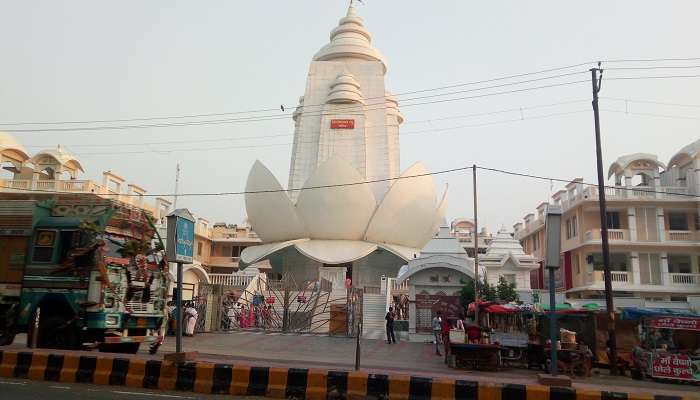
The lotus flower as we all know is quite a sacred symbol to the religions of Hinduism and Buddhism as well. It symbolises purity, enlightenment and mainly rebirth of the soul. It is quite a powerful symbol that can be seen in multiple paintings and scriptures of ancient times. So, for a temple to be constructed based on this flower, it is quite a powerful spiritual symbol. The Lotus Temple Vrindavan also known as the Priyakant Ju Temple is a prominent Hindu temple located in Vrindavan. This town is one that is deeply revered in the Vaishnavism tradition for its association with Lord Krishna which is why this temple stands out not only for its religious significance but also for its unique architectural design.
The Lotus Temple – A Brief History
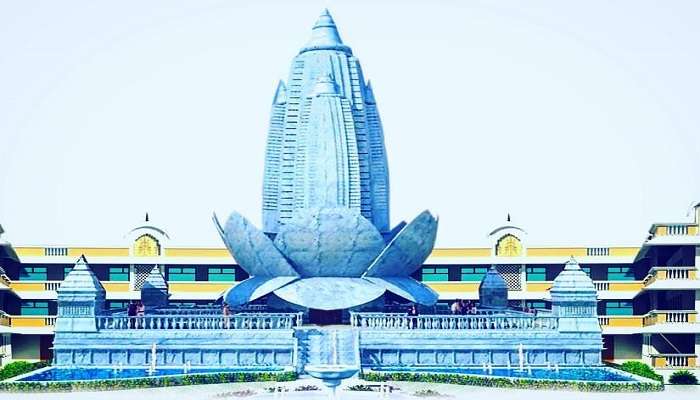
This temple was established by Shri Devaki Nandan Thakur Ji Maharaj and its construction was supported by the World Peace Charitable Trust. The foundation stone for the temple was laid in 2009, and it took almost seven years to complete, it is also interesting to know that during the foundation laying ceremony, a lotus flower was placed under the foundation stone to signify that this temple will be built over a lotus flower. The first phase began in 2012, and the temple was finally opened to the public on February 8, 2016, and was attended by millions of devotees and dignitaries, including Shri Kaptan Singh Solanki, the Governor of Haryana at the time.
Although most visitors might draw an immediate comparison to the much larger Lotus Temple of Delhi, these are two very different structures with very different purposes, and it is not a fair comparison to begin with. Vrindavan has an ancient past, associated with Hindu culture and history, and was established in the 16th and 17th centuries as a result of an explicit treaty between the Muslims and Hindu Emperors, and has been an important Hindu pilgrimage site for a long time.
Must Read: Things To Do In Vrindavan
The Design And Architecture
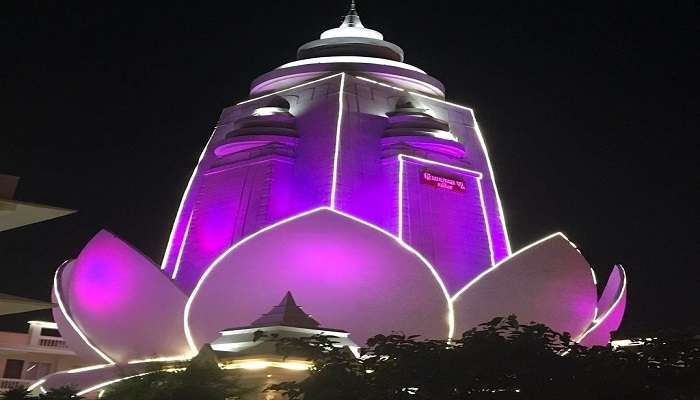
The Lotus Temple at Vrindavan is named and known for its distinctive lotus shape, symbolising purity and beauty. It is constructed using Makrana marble which is mined in the town of Nagpur and is known for its high quality and strength and is used in other iconic structures like the Taj Mahal. The temple rises to a height of about 125 feet, making it a prominent landmark in Vrindavan. The temple is surrounded by water tanks and fountains, adding to its serene and picturesque design. These features are also intended to enhance the spiritual ambience while also providing a tranquil environment for worshippers and visitors.
Inside the temple, there is a cave that provides a unique experience for visitors. This cave is adorned with lighting effects that create a mystical atmosphere in the temple. Also part of the temple complex are smaller shrines dedicated to various deities such as Lord Ganesha, Hanuman, and Shiva, reflecting the inclusive nature of Hindu worship practices. The architecture of the Lotus Temple, while modern, incorporates elements of traditional Indian temple design. It blends North Indian temple architecture with contemporary aesthetics, making it both a spiritual and visual marvel. The use of Makrana marble and the lotus design is particularly noteworthy, representing a blend of purity, devotion, and architectural innovation.
Places To Visit In And Around The Temple
You are now immersed in the beauty and architecture of the Lotus Temple. Get ready to explore the famous places in and around the temple to create memories that will be cherished forever. The following is the list that you can read.
1. Keshi Ghat
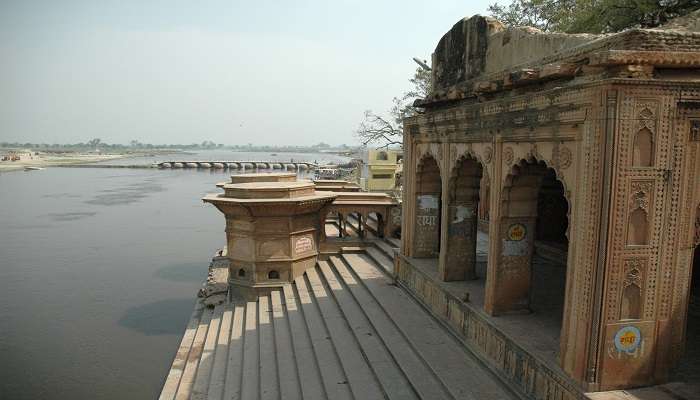
Originally constructed in the 17th century by Queen Laxmi Devi of Bharatpur, the Keshi Ghat is located on the banks of the Yamuna. Nearly all of Vrindavan’s major temples are located on this lovely ghat, making it a site of immense spiritual and heavenly significance. A recurring motif in the building and construction of the temples in Vrindavan is the subtle nod to Rajasthani influences. The design of the stairs leading from the Keshi ghat to the temples demonstrates how this motif also continues there.
Keshi Ghat, one of Vrindavan’s most famous and popular tourist destinations, is the perfect place to take in the captivating dawns and dusks. In addition to appreciating and capturing photos, you can arrange a boat ride to the centre of the river to witness all the evening pujas and aartis from afar.
Suggested Read: Temples In Vrindavan
2. Prem Mandir
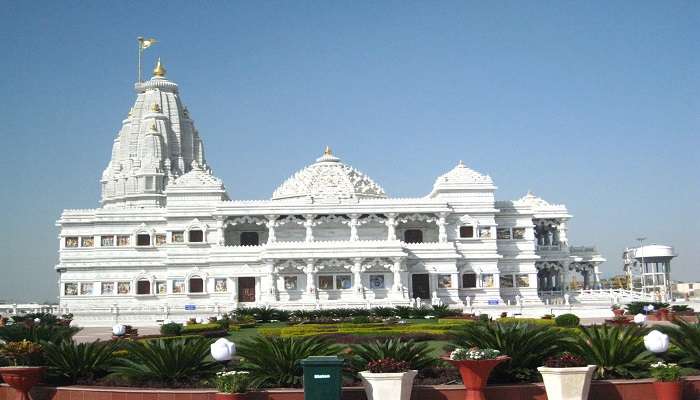
Prem Mandir is situated in the Uttar Pradesh district of Vrindavan, close to Mathura. Jagadguru Kripalu Maharaj constructed it as a temple to Lord Krishna and Lady Radha. Kripalu Ji Maharaj laid the foundation stone for this temple on January 14, 2001.This temple’s construction took eleven years and cost over 100 crore rupees. It was crafted by more than a thousand artisans from Rajasthan and Uttar Pradesh using imported white Carrara marble. A prime example of the revival of traditional Indian architecture is this temple.
The whole temple is 125 feet in height, 122 feet in length, and 115 feet in breadth. It is constructed over 54 acres. Beautiful artwork portraying the lives of Lord Krishna and Lady Radha may be seen in the surrounding gardens. Today, it stands as a divine icon of love and is open to people of all castes and religions free of cost. The Prem Mandir opens at 5:30 pm and closes at 8:30 pm.
3. Banke Bihari Temple
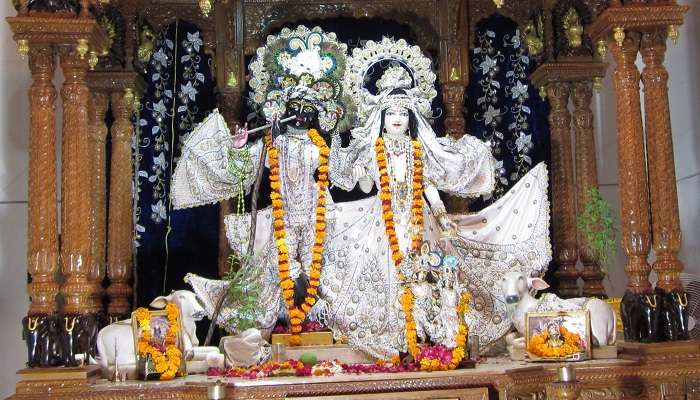
The Hindu temple, Banke Bihari Temple, is in the town of Vrindavan. The object of devotion at this temple is Banke Bihari, who is said to be a hybrid of Krishna and Radha. Originally, Bihari was worshipped in Nidhivan. However, the image of Banke Bihari was transported to its current temple when the Banke Bihari temple was built, perhaps about 1864. At this temple, the Banke Bihari statue is positioned in the Tribhanga pose. It is said that the united form of the celestial pair Radha and Krishna is represented by the Banke Bihari icon. The saint and musician Swami Haridas of Vrindavan, who was said to be the incarnation of Lalita Gopi, a close friend of Radha Krishna in their celestial home of Goloka, materialised the image.
Banke Bihari is revered as a little infant in the Banke Bihari temple. Because of the potential for upsetting Banke Bihari, no early morning aarti is offered and no bells are strung anywhere on the temple grounds. Early morning aarti is conducted only on Krishna Janmashtami Sunday.
Further Read: Things To Do In Vrindavan
The Lotus Temple in Vrindavan is not just a place of worship but also a symbol of architectural brilliance and spiritual tranquillity. It stands as a testament to the enduring legacy of Hindu temple architecture and reflects modern-day devotion and aesthetic values. Its serene environment and stunning design make it a must-visit destination for pilgrims and tourists alike, offering a unique blend of spirituality and architectural splendour. So do visit the Lotus temple on your next trip to Vrindavan.
For our editorial codes of conduct and copyright disclaimer, please click here.
Cover Image Credit: My beloved Vrindavan on Facebook
Frequently Asked Questions About Lotus Temple In Vrindavan
How long will it take to fully explore the town of Vrindhavan?
It will take around 2 to 3 days to fully explore this town and its temple but you can take longer if you want to take your time on the trip.
How's the weather in Vrindavan?
Vrindavan has your typical tropical weather with hot summers, thunderous monsoons and comfortable winter which makes winter the best time to visit this place.
Is there a dress code for entry to temples in Vrindavan?
Yes, there is a strict dress code that only allows full-length pants and dhotis for men and a shawl has to be worn over the heads of women when they enter the temple premises.
How long will it take to cover the Lotus temple in Vrindavan?
With the full aarti and puja package it will take around an hour to fully explore this temple. However you can stay for the more time after the arti at the Temple.
Is the Lotus temple in Vrindavan modelled after the one in New Delhi?
No, both these structures although similar in theme and design are constructed with 2 completely different purposes in mind.
People Also Read:
Kashi Vishwanath Temple Poornathrayeesa Temple Meenakshi Temple

Unveil the hidden treasures of the globe and turn every travel dream into reality. As a Content Writer, I am passionate enough to craft stories from ancient wonders to modern marvels. My words paint the picture-perfect itinerary for unforgettable experiences. Let my words be your trusted guide to immerse in the diverse culture and discover the beauty of the unknown.











